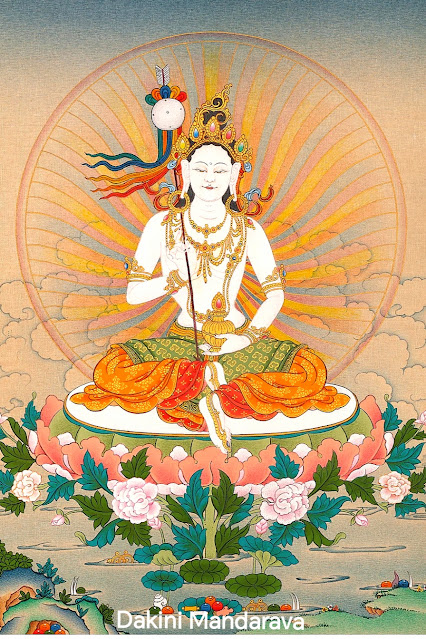Tibetan Buddhist mantras are words originally spoken by a Buddha while deep in meditation. Reciting them helps to replace the endless internal chatter of the mind with calming syllables that purify karmic imprints, bring beneficial energy, focus concentration, and offer protection and blessings.
Chanting a mantra cannot by itself liberate a person from cyclic existence. While chanting, one also must transform and focus one's thoughts.
To engage the mind in this way requires preparation—receiving teachings from a qualified master, reflecting on and contemplating those teachings, and engaging in skillful meditation practice.
The fundamental reason for the use of mantras in meditation is the deity.Why are mantras said in Tibetan Buddhism? What is their significance and power?
Mantras are customarily an important aspect of Tibetan Buddhist practice. They usually correspond to specific deities; each deity has one or more mantras associated with him or her. Therefore, the reason for reciting a specific mantra is the wish to achieve the qualities associated with that specific deity.
If someone wishes to develop discernment, they might meditate on Manjushri and recite his mantra.If purification is the main emphasis in practice, meditation on Vajrasattva and the recitation of his 100-syllable or six-syllable mantra are recommended.
Om Mani Padmi HungThe most commonly practiced mantra is OM Mani PADME HUM, the principal mantra of Avalokiteshvara, the Bodhisattva who embodies the compassion of all Buddhas.
The development of impartial love and compassion is the essence of spiritual practice; in the same way, this mantra is the essence of all mantras.
Its six syllables prevent rebirth in the six realms of samsara and contain the essence of the buddhas who liberate the six realms, as well as the essence of the six perfections practiced in the Mahayana.
The fundamental reason for the use of mantras in meditation on deities is that a deity's mantra is no different than that of that of that deity himself or herself.You can regard the recitation of a mantra as calling a deity by name, and indeed, many mantras are phrased in that way. But really, a mantra is more than the deity's name; it is the deity appearing as sound. For that reason, the written form of a mantra is regarded as a type of Nirmanakaya Buddha.
Donations for our Buddhist research and development.Do you earnestly cherish our devoted work? Assuming this is the case, we are delighted that you are finding our blog useful and valuable. Would you consider making a donation for our Buddhist research and development?
We need your help to secure the future of scholarly interaction with Buddhism. Since our very first publication of Dharma works and activities in 2008, we have been effortlessly providing free distribution of Dharma posts and articles throughout the previous 16 years.
We have exceptionally constrained support and do not receive subsidies or funding from people in general.
Please help us develop our Dharma activities that will not only benefit you but all Dharma readers on the planet. Please consider showing your support. Your generosity will certainly help us enhance our work and accomplish more for a better and brighter future.
Thank you for reading. May you find peace and great bliss. With your support, it helps to spread the Buddha’s precious teachings and turn the Dharma wheels in the world.
For those in whom the precious Bodhichitta has not arisen
May it arise and not decrease.
But increase further and further.
By this merit, may we then obtain omniscience then.
Having defeated the enemies wrongdoings
May we liberate migratory from the ocean of existence.
With its stormy waves of birth, old age, sickness, and death.
*Note
Picture(s) courtesy and credit to the rightful distributors and/or studios
The picture(s) are intended for editorial use only.























